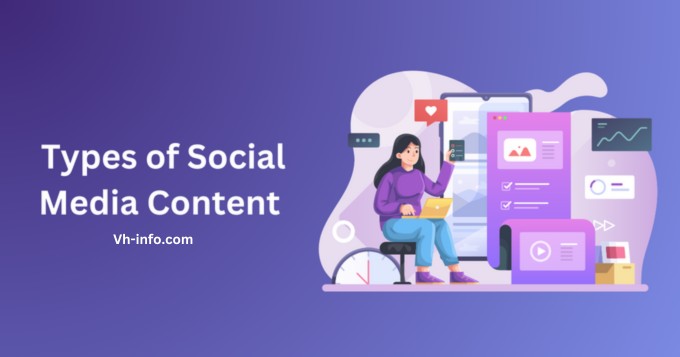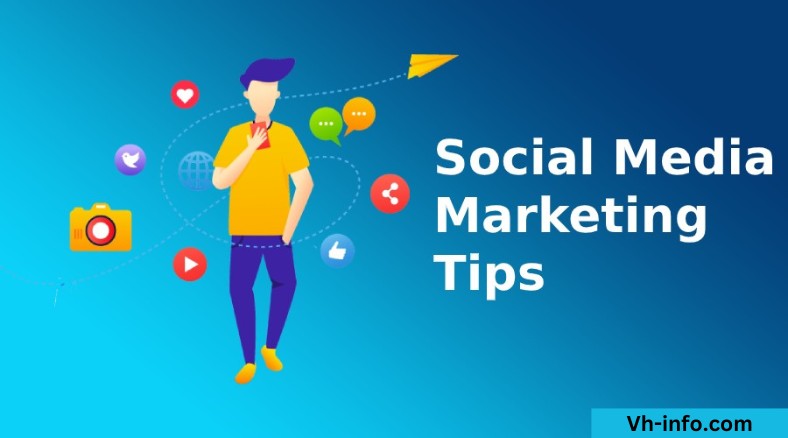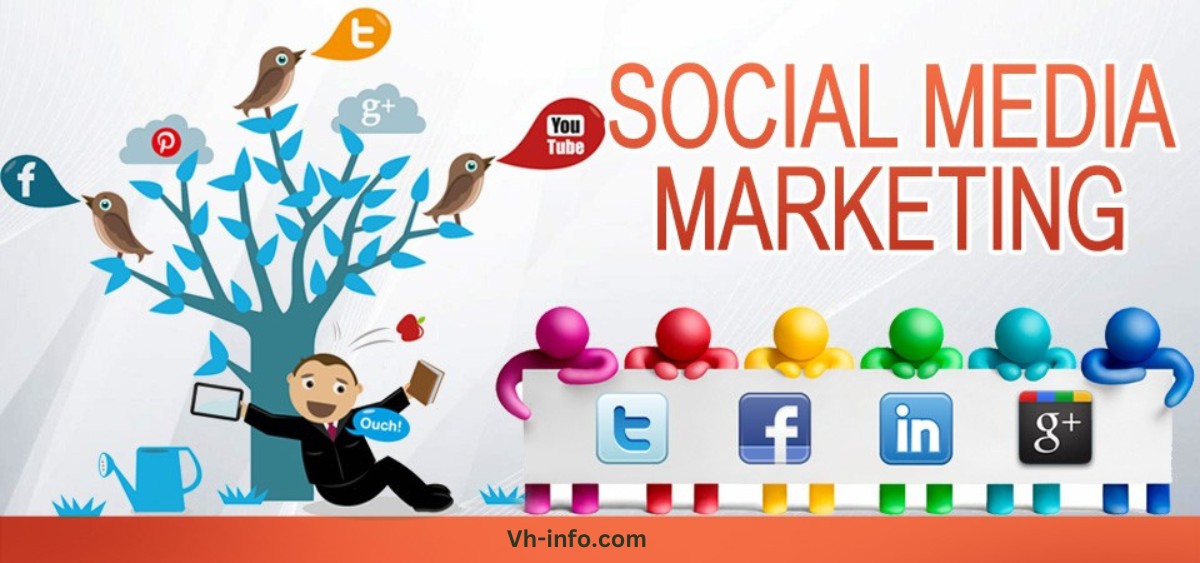Social media marketing is a powerful tool for businesses aiming to connect with their audience.
However, navigating the vast array of strategies and platforms available can feel overwhelming.
In this comprehensive guide crafted in collaboration with VH-Info, a leading SaaS link-building agency, we’ll explore the diverse landscape of social media marketing.
Covering platforms, content types, and effective strategies, we aim to equip you with everything necessary to bolster your online presence.
Our guide includes insights on choosing the right platforms for your business and showcases successful marketing campaigns.
Whether you’re new to social media marketing or seeking advanced strategies, our guide ensures you’re well-equipped to elevate your approach.
What is Social Media Marketing (SMM)?

Social Media Marketing (SMM) is a vital aspect of digital marketing that leverages the influence of various social media platforms, such as popular social media networks, to meet branding and marketing objectives effectively. It is like using the power of social media sites to help businesses grow. It’s not just about making profiles and posting stuff whenever. It’s more strategic. SMM involves making your profiles look good, sharing cool pictures, videos, and stuff that show off what your brand is about, and talking with people who follow you. It’s also about using ads to reach specific groups of people. Overall, SMM panel services is about using social media networks to get more people interested in your business, talk with them, and keep up with all the new things happening online.
Why Is Social Media Marketing (SMM) so Powerful?
Here are a few reasons why social media marketing (SMM) is so powerful:
- Large reach – Social platforms have millions of daily active users. This allows marketers to instantly reach a large targeted audience.
- Engagement – Unlike traditional ads, social content has the ability to be shared and liked. This drives higher engagement and brand interaction.
- Real-time communication – Social platforms facilitate two-way communication between brands and consumers for faster, more personal interactions.
- Data and insights – The analytics from social platforms provide deep data and insights to help target audiences and shape content strategy.
- Cost-effective – Getting started with social media marketing has a very low barrier to entry compared to other marketing mediums. The ability to organically reach a large audience makes it extremely cost-efficient.
Types of Social Media Marketing

Content Marketing

Content marketing means making useful things and showing them to the people you want to reach. You want these things to be interesting and catch their attention.
The goal of content marketing is to make the people who see your stuff trust you more. When they trust you, they might buy things from you later on.
To do content marketing well, you have to make really good blog posts, cool pictures with information, videos, and other things that the people you’re trying to talk to will like. Content marketing is a powerful strategy that involves creating and sharing valuable content to attract and engage an audience. This can include blog posts, infographics, and videos. Utilizing video templates can streamline the process of producing high-quality video content, ensuring consistency and saving time.
You should also share your stuff a lot, like on social media and through email. That way, more people will see it.
Social Media Advertising

Social media advertising is when you pay to show more people the things you want to sell or tell them about on social media.
On Facebook, you can use something called “Facebook Ads” to choose who sees your ads based on things like their age, what they like, and what they do.
Other places like Twitter, LinkedIn, and Instagram also let you pay to show your ads to specific groups of people. If you do it the right way, these ads can work really well.
Influencer Marketing

Influencer marketing is when companies team up with popular people on social media.
These popular folks are called influencers. They have lots of followers and are seen as experts in certain things.
To make influencer marketing work, you need to find influencers that fit your audience. Then, you can ask them to talk about your stuff in their posts, videos, or blogs.
Social Media Engagement

Social media engagement means talking and connecting with the people you want to reach on social media. It’s like making friends and keeping them interested in what you’re sharing.
The idea is to make a group of people who like your brand and trust you. To do this, you have to post things that catch their attention and make them want to join in the conversation.
It’s also important to reply when they say something or ask questions. This shows you care about what they think.
Running fun contests or giving away prizes on social media can also make more people get involved and become closer to your brand.
Paid Media Marketing

Paid media marketing is like renting space to advertise online. It means paying to show your ads or content on the internet, including pay-per-click ads, sponsored posts, or banners on websites. This could be through platforms like Google Ads. It’s super important for online businesses because it helps more people know about the brand and can bring in more money.
Read More : How to Pin a Tweet 2024 Complete Guide
Social Media Marketing Examples
Here are some real-world examples of impactful social media marketing from top brands:
- Nike – Nike uses compelling visual storytelling across social platforms. Their creative and inspirational video ads inspire audiences, like their uplifting messages celebrating women in sports.
- Starbucks – Starbucks leverages seasonal and specialty beverage launches through hashtags, videos, shoppable Instagram reels and posts, and contests. This hooks viewers and inspires them to try the flavors.
- Wendy’s – Wendy’s made a name for itself in social with their witty, viral, and sassy tweets. Their edgy personality shows brands can take risks on social while entertaining.
- Taco Bell – Taco Bell combines humor and seasonality with content like showcasing unique taco shells shaped like hearts for Valentine’s Day or trees for Christmas, generating interest and buzz.
- GoPro – GoPro shares viewer-generated content of their products in action through video compilations and regrams. This gives potential customers social proof of how GoPro is used.
- Sephora – Across their social channels, Sephora showcases new products with bright, captivating imagery while highlighting their makeup artists’ tips and tricks through IGTV tutorials.
These examples demonstrate the power of fusing creativity, value, and engagement across social content!
As a link building agency skilled in generating more brand visibility, VH-Info would be a powerful ally for any of these brands’ social media campaigns. By fostering more awareness through savvy outreach resulting in earned links and embeds, VH-Info can dramatically boost engagement and conversions across diverse platforms and creative content. The opportunities to collaborate are extensive!
Types of Social Media Marketing Platforms
Traditional Social Networking Sites
Here are some examples of traditional social networking sites: Facebook, LinkedIn, X (previously known as Twitter), and Threads.
They’re used to talk to customers in specific areas or groups where they share common interests.
Your business can use these sites to make your voice louder and connect with your audience. They let you share words and pictures with whoever you want. You can use features like making connections, setting up events, and advertising.
These platforms learn a lot about their users. This helps you show ads to specific groups and connect with the right people. You can share helpful stuff, talk about local events, or even hold contests.
Also, you can use messaging tools to talk directly to customers. It’s helpful for quick answers to simple questions they might have.
Image-Based Social Media
These apps like Instagram, Pinterest, Snapchat, and TikTok (with the photo mode) focus on images.
They’re great for telling stories with pictures, building your brand, and selling stuff.
For businesses, these apps are perfect for social commerce. They let you sell things without sending customers to another website.
Here’s how each one helps:
- Instagram Shopping: You can make a shop on your profile, tag products in your pictures, and mention them in your bio.
- Pinterest Shopping: Connect your store and add links so people can buy from search results. You’ll get a badge showing you’re a trusted seller.
- Snapchat Store (in beta): Verified business profiles can upload catalogs and add a shop tab.
- TikTok Photo Mode: It’s like Instagram’s picture slideshows. You can add music and use it to show products, announce sales, or share stories.
These apps are super useful, especially if your customers are younger, as Snapchat is popular among 13-24-year-olds in many countries.
Short-Form Video Social Media
Here are places like Instagram Reels, TikTok, and YouTube Shorts. They’re all about sharing short videos, usually between 5 to 90 seconds long.
Businesses can use these platforms to make short videos that show off their brand and products.
Short videos are quick to make and are great for businesses with small social media teams. There are always new trends on these platforms, so you can easily find ideas for your next video.
Remember, your videos should be fun, teach something, or inspire your viewers. Avoid making videos that feel like you’re trying to sell something. Those won’t interest people much.
Livestream Social Media
These are places like Facebook Live, Instagram Live, TikTok Live, Twitch, and YouTube. They’re all about showing live videos to lots of people at the same time.
Businesses can use these platforms to do live shows. During the pandemic, a lot of people started watching these kinds of videos. By late 2022, almost 30% of internet users aged 16-64 were watching live videos every week.
You can use live videos to launch new products, interview famous guests, or have Q&A sessions.
Live videos let people chat and vote while watching. They also let viewers talk directly with the hosts. So, it’s important to pay attention and talk back to the comments while the video is happening.
Discussion Forums
These are places like Reddit and Quora. People use them to ask questions, give answers, and connect with others who share their interests.
Businesses can join these platforms by giving helpful answers related to their industry. But it’s important not to sound too much like advertising.
The trick is to provide useful information and solutions to people’s questions. If you talk about your products, make sure it fits naturally in the conversation. But the main goal should be helping, not selling.
Redditors don’t like when businesses only promote themselves. They might push those posts down in the feed by downvoting them.
If your business joins a discussion, focus on answering the question first. Only share links to your products if it genuinely helps. Also, check the rules of the forum before sharing links about your business.
For instance, Microsoft joined Reddit’s /r/XboxOne to chat with gamers and give tech support. They didn’t create the subreddit, but they saw its popularity and started engaging with users.
Private Community Platforms
These are places like Discord, Facebook Groups, Patreon, and Slack. People use them to build communities and sometimes need permission to join.
Businesses can use these private groups to bring people together who share common interests. Members can help each other, and businesses can engage with them.
In these groups, businesses can:
- Connect with customers
- Ask for user-created content
- Organize contests and special offers
For example:
- The Sorry Girls made a course with access to a private Discord server for their biggest fans.
- Instant Pot’s Facebook Group has over 3 million fans sharing recipes and tips.
- To join, users answer a few questions, which helps Instant Pot understand their users better and make content that helps them.
Decentralized Social Networks
These are platforms like Bluesky and Mastodon. People use them to make their brand known, talk with their community, and see what people are talking about.
Businesses can use these platforms to:
- Connect with users and do community work Professionals with an MSW degree can leverage these opportunities to enhance their outreach and impact in social work.
- Run campaigns where users create content
- Do research by listening to what people are saying
Mastodon and Bluesky are different from usual social media. Regular platforms keep all the information on one server controlled by a company. But decentralized ones, like Mastodon, spread data across many servers. This means no single company controls all the data, and users can chat across servers without worries about data control or censorship.
For businesses, these platforms may not allow ads. However, businesses are still using them to build communities, learn about the market, and grow their brands.
Types of Social Media Content

Here are some of the most popular types of social media content that brands create:
- Blog Posts – In-depth articles published to your website that you can promote on social media. They help establish your brand as an authority and thought leader.
- Infographics – Visual representations of data, stats or processes. They simplify complex information into easy-to-digest graphical formats.
- Videos – From quick video posts to longer YouTube tutorials and demonstrations, video engages audiences through sight, sound and motion.
- Images – Photos, illustrations, memes and more that catch the viewer’s eye and convey emotions and ideas quickly. Images tend to get high engagement.
- Stories – Temporary posts like those on Instagram and Facebook Stories that give followers a behind-the-scenes, authentic look at your brand. They feel more raw and real.
- Live Videos – Streaming real-time footage to followers allows them to interact and engage with you and other viewers through comments and reactions.
- Contests/Giveaways – Offering free products/services makes fans excited about your brand and incentivizes shares and engagement.
- Quizzes/Polls – Interactive content that allows followers to express opinions and compare thoughts. This can collect valuable data for your brand.
Benefits of Social Media Marketing
Social media management and marketing offers great ways to boost your business.
Here are some benefits:
- Build relationships: Connect directly with people, get feedback, and chat with followers. It helps create a friendly image for your business.
- Increase brand awareness: Use images to make your brand familiar to many people. The more they know you, the better your ads and other marketing will work.
- Drive traffic: Share links to your website in posts and ads. More visitors mean more potential customers.
- Humanize your business: Make your business feel like a person. Interact with users and build trust.
- Generate leads and customers: Use features like shops, messaging, and call-to-action buttons to get more sales.
The more people engage with you on social media, the easier it becomes to achieve your marketing goals.
The Essentials of a Successful Social Media Marketing Strategy

A good plan for social media marketing can vary for each business, but here are some key things they all share:
- Knowing your audience: Understand who your audience is, what they like, and where they spend time online.
- Brand identity: Decide what message you want to send and how you want people to feel when they see your posts.
- Content plan: Even though social media can be spontaneous, having a plan helps to keep a consistent voice and share good content regularly.
- Using analytics: Numbers and data help you understand who you’re reaching, what content works, and the best times to post.
- Being active: Posting regularly, engaging with people, keeping up with trends, and making sure your profiles are accurate are important.
- Helping, not just selling: Instead of just advertising, focus on providing helpful and interesting content. This builds your reputation, and others might promote you too.
How to choose the best types of social media for your business?
- Know your audience – Take time to research and analyze who your target customers are, what demographics they represent, what content and platforms they engage with, and what motivates them. This will allow you to make informed decisions about which social platforms your branding and messaging will resonate on.
- Align to your key business goals – Be very clear about what your priorities are through social media. Is it brand awareness, sales conversions, customer support? Connect your goals to metrics so you can track performance and choose platforms that will optimize desired outcomes.
- Create content tailored to the platform – Every social media platform has unique formats, expectations, and norms. The same content may flop on TikTok but take off on Twitter. Craft content – whether video, visual, textual – that aligns to each platform’s style and voice for best results.
- Keep up to date with social media statistics – Social platforms rapidly introduce new features while usage and trends constantly evolve. Stay knowledgeable by regularly checking each network’s user statistics to spot opportunities to leverage emerging functions or double down on the most engaging networks.
Read more: How to choose the right social media marketing tool for your business
The Best Social Media Marketing Platforms for Business

These are the best social media channels you should be on. Whether it is just for your personal brand or getting in website traffic, these are the top social media platforms with maximum social media users that can help you achieve your business goals and reaching out to a wider audience:

Facebook is a huge place where lots of people hang out every day—nearly 1.9 billion!
It’s popular among both Generation X and Millennials, and it’s great for businesses that sell to customers (B2C).
It’s perfect for making more people know about your brand, showing ads, and building a community. Facebook has lots of tools for advertising and also chances to get noticed without paying.
YouTube

YouTube is a huge website with more than 315 million people visiting every day!
Mostly, it’s used by Millennials, but people of different ages and genders like it too. Both businesses that sell to other businesses (B2B) and those that sell to customers (B2C) benefit from it.
It’s amazing for making more people know about your brand, sharing longer videos for entertainment and teaching, and also for getting noticed in online searches. People spend a lot of time on YouTube because there are lots of educational videos there. It’s a great place to build a community too!

Instagram has about 1 billion people using it every month!
Mostly, it’s used by Millennials. Businesses that sell to customers (B2C) find it really helpful.
People love sharing great pictures and videos here, and businesses can advertise too. What’s cool is that Instagram has tools that let you buy things you see without leaving the app. It’s a really popular place for brands!

LinkedIn is a bit like Facebook, but it’s more for professionals.
About 774 million people use it, mostly Baby Boomers, Generation X, and Millennials who are working.
It’s really good for businesses that sell to other businesses (B2B). People here are looking to make connections and find job opportunities. For B2B companies, it’s great to find important people in their industry and make a community.
X

X is a place where about 211 million people chat every day!
Mostly, it’s used by Millennials. Both businesses that sell to other businesses (B2B) and those that sell to customers (B2C) use it.
It’s really good for talking with the public, helping customers, and making a community. Twitter started with short messages but now has more features like spaces for audio, communities for groups, and moments to share cool stuff with your followers.
Snapchat

Snapchat is used by about 306 million people every day!
Mostly, it’s used by Generation Z. Businesses that sell to customers (B2C) find it helpful.
Snapchat started the trend of sharing content that disappears after 24 hours. It became really popular when it launched in 2011 and even though Instagram has a similar feature called Stories, Snapchat is still loved by many young adults.
TikTok

TikTok is a place where about 1 billion people visit every month!
It’s mostly used by Generation Z, followed by Millennials. Both businesses that sell to other businesses (B2B) and those that sell to customers (B2C) can benefit here.
TikTok is awesome for making short and fun videos, getting people to create content, and making more people know about your brand. It’s really good for building a community, and marketers think it’s just as cool as YouTube for that!

Pinterest is like a place where about 444 million people go each month!
Mostly, it’s used by Millennials, but folks from Gen Z, Gen X, and Baby Boomers also like it. It’s perfect for businesses that sell to customers (B2C).
Imagine it as a place where you can collect pictures for ideas, like for fashion or home decorations.
85% of Pinners say Pinterest is where they go to start a new project. And 80% of those who use it weekly find new brands or things to buy. Brands can tell their stories using pictures here, which helps people discover them. It’s a cool way to show off visually!
Clubhouse

Clubhouse is making a comback as a social place where about 10 million people used to chat each week!
Mostly, it’s used by Millennials. It’s good for businesses that sell to other businesses (B2B) and those that sell to customers (B2C).
It’s different because it’s all about talking—no pictures, just voices. People can have cool talks with friends or even people they don’t know.
When it started, it was only for some people, but now everyone worldwide can join, whether they have an iPhone or an Android. It’s cool because audio is becoming popular again, and this platform uses that well for both types of businesses.
How to Use Social Media to Grow Your Business?

Now that you know about the various ways of using social media for marketing, let’s discuss how you can use social media to make your business bigger.
Use social media to create valuable content
Good content is super important in social media marketing.
To get people interested and involved, make awesome blog posts, cool infographics, videos, and stuff that your audience likes.
Also, share your cool content a lot on social media and through emails. This helps more people see it!
Use social media to connect with potential and current customers
Social media is like making friends for your business.
To make your business bigger, talk to people who might buy your stuff. Share helpful things, answer their comments and questions, and have fun contests or giveaways on social media.
Use social media to stay up-to-date with industry trends
Social media helps you keep in touch with what’s new in your field.
You can use it to see the latest news, find out about new things that might help your business, and even connect with experts in your field. That way, you can stay updated on the newest trends.
Use social media to generate leads and sales
Lastly, social media can help social media marketers and businesses find people who might buy from their business.
You do this by sharing useful things and showing your products to the people who might like them. Also, by talking to possible customers and making friends with them on social media.
Social Media Marketing Tips

Here are some quick tips to start your social media marketing with a good social media presence:
- Create different types of content: Share useful things like tips, local news, polls, and updates. Use various formats like images, videos, stories, and more.
- Stay consistent with your brand: Keep your identity the same across different social media sites. Be friendly, fun, or reliable, but stay consistent.
- Engage, don’t just post: Social media is about chatting. Reply to comments, like, share, and run live sessions to connect with your audience.
- Use tools for creating content: Make attractive visuals for your posts using tools like Freepik and Canva Make sure they look professional and match your brand.
- Reuse and repost content: Recycle good content in different ways. Turn reviews into Facebook posts, share your best blog posts monthly, and post your videos on various platforms.
- Follow others for inspiration: Follow competitors, influencers, and brands with good strategies. Learn from them and get ideas for your own social media plan.
- Measure your success: Use tools like Google Analytics to track what’s working. It helps you know which strategies are successful and which ones to change.
- Try paid advertising: Use platforms like Facebook, Pinterest, and Instagram for cost-effective ads. They can help your content reach a bigger audience that’s interested in your business.
That’s a quick way to start marketing on social media!
Conclusion
In conclusion, social media marketing offers a wide range of opportunities for businesses to connect with their target audience and drive results.
Whether it’s through content marketing, social media advertising, influencer marketing, or social media engagement, there are various types of strategies that can be implemented.
Understanding the different types of social media platforms and knowing how to tailor your content to each platform is key to success.
Additionally, it’s important to have a well-defined social media marketing strategy that aligns with your business goals and target audience.
Remember to keep these tips in mind and leverage the power of social media to grow your business.

